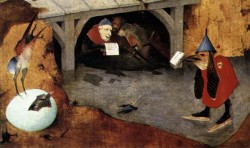
Massing 1994
“Sicut erat in diebus Antonii: The devils under the bridge in the Tribulations of St Anthony by Hieronymus Bosch in Lisbon” (Jean Michel Massing) 1994
[in: John Onians (ed.), Sight and Insight. Essays on Art and Criticism in Honor of E.H. Gombrich at 85. Phaidon, London, 1994, pp. 108-127]
Bosch was a moralist who was obsessed by the devil and by the deadly sins. Writing about Bosch’s Temptations of St. Anthony in 1605 José de Sigüenza already signalled the fantasiae that were conjured up by the devil to tempt the saint. Such fantasiae or phantasms are also mentioned in several texts, such as Athanasius’ Life of Anthony. Deceptive delusions, evoked by the devil to corrupt and scare Anthony, fill the central panel of the Lisbon triptych. Late-medieval psychological theories support the belief in such phenomena. According to the Malleus Maleficarum the devil was not only able to conjure up these phantasms during dreams, but also during someone’s waking life.
Whereas the central panel depicts the devil’s trials to distract Anthony from his pious life, the wings refer to more specific episodes from his vita. On the right inner wing Anthony is being seduced by a naked woman, probably the devil-queen who appeared to the saint (according to an anonymous Arabic legend which was translated by the Dominican Alphonsus Bonhominis and which was well-known in the late Middle Ages). The left wing shows Anthony’s fight with demons in the desert, an episode from the vita written by Athanasius.
At the bottom of this left wing we see some devils under a bridge. One of them is a diabolical messenger with a letter attached to his beak (the letter A on his messenger’s badge refers to Anthony). The word protio (= protestatio) on the letter, written mirrorwise, signals that these devils are real diaboloi or fake accusers. They try (in vain of course) to collect Anthony’s sins in order to accuse the saint. Massing signals a number of other examples in late-medieval images where devils are jotting down the sins of people in order to use these sins against them. In this way Bosch expresses his contemporaries’ fear for the devil, and more precisely their fear of being unjustly accused by the devil of sinfulness. Massing states that this specific fear was stronger in the beginning of Christianity than in Bosch’s own days.
One wonders how the dead black bird (shot by an arrow), lying on the ice between the devils under the bridge and the diabolical messenger, fits in with this interpretation.
[explicit]